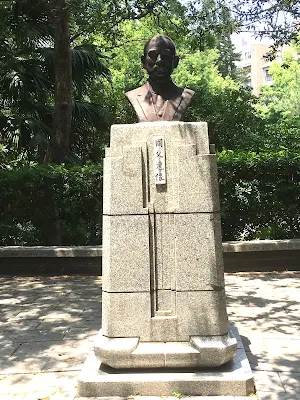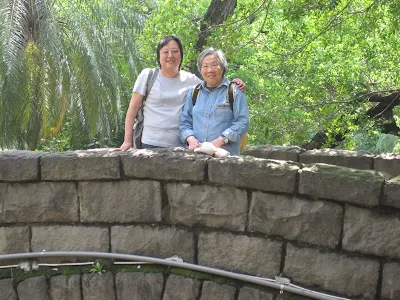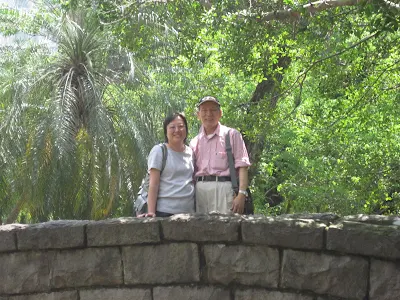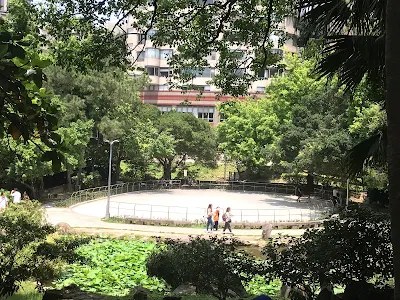Today, my sister and I took my daughter to visit the place where we grew up as children — Beitou. Beitou is located in the northwestern suburbs of Taipei City and is the second-largest administrative district in the city. Its name comes from the indigenous Basai people, who believed that the steam rising from the local geothermal valley was caused by witches casting spells. They named the area after a witch, "PATAW" (also known as Ba Island), in the Basai language. Over time, the name evolved to resemble the Taiwanese pronunciation of "Beitou."
Beitou District is rich in natural resources. As early as the 17th century, Spanish records mentioned that Beitou was abundant in sulfur. In 1896, a Japanese businessman established Taiwan’s first hot spring hotel there.
I lived in Beitou until my senior year of high school, when I moved to Taipei City. I miss Beitou deeply, and in this article, I’ll include many old photos from our visit to various spots around the area.
今天,我和妹妹帶我女兒去了我們兒時長大的地方──北投。北投位於台北市西北郊,是台北市第二大行政區。它的名字源自於原住民巴賽族,他們相信當地地熱谷會冒煙是巫婆施法所致。他們用巴賽語以女巫的名字為這片區域命名,稱為「PATAW」(巴島)。隨著時間的推移,這個名字逐漸演變成與「北投」的台語發音相似。
北投區自然資源豐富。早在 17 世紀,西班牙文獻即有記載北投盛產硫磺。 1896 年,日本商人在此設立了台灣第一家溫泉旅館。
我從小在北投長大,直到高三搬到台北,因而對北投有很深的懷念。所以在這篇文章裡,我會分享一些我們一起遊覽北投各個景點時拍的照片及許多舊照。
Qingjiang Elementary School 清江國小
Our first stop was the primary school where my mother used to teach — Taipei Municipal Qingjiang Elementary School. Of course, the school and the surrounding environment are very different from how they were more than 50 years ago.
我們的第一站,是我母親曾經任教的小學——台北市立清江國小。當然,現在的學校和周圍的環境,已經和 50 多年前大不相同了。


Old Home 舊家
Then we went to take pictures outside our old apartment. I lived there for two years during elementary school, three years of junior high, and two years of high school. Because the area was quite remote, we often had to walk 15, 20, or even 30 minutes to Old Beitou to catch a bus or get to school—especially if we didn’t want to wait for the bus that only came once an hour. That kind of natural walking (or speedy walking) routine from childhood was actually good for our health.
I also remember that when I was in high school, I had to catch the first bus of the day. I studied on the crowded bus, standing the entire way until we arrived in Taipei. Those days really feel like a long time ago.
然後我們去舊家公寓外面拍照留念。我在這裏渡過我的兩年小學、三年國中及兩年高中。因為地處偏僻,我們常常要步行 15 分鐘、20 分鐘甚至 30 分鐘到舊北投去搭公車或上學——尤其是當我們不想等每小時才一班的公車的時候。這種從小養成的走路 (快走) 習慣其實對我們的健康有很大的助益。
我還記得高中的時候,每天要趕第一班公車上學。在擁擠的公車上啃著書,搖搖晃晃站到台北,那真是很遙遠以前的日子。


Church 聚會的會所
The next stop was the church meeting hall where we attended gatherings when we were children. I remember there used to be a wall here, and the meeting place was originally a bungalow (see the old photo below that my friend found online for me). At the front of the meeting hall was a platform covered with wooden boards, and underneath it was a pool used for baptisms. Now, a new building has been constructed, and there is more space available for gatherings.
接著我們到小時候聚會的會所。我記得這裡以前有一面牆,聚會的地方原本是一棟平房(請看下面朋友在網路上幫我找的舊照片)。聚會大廳的前方有一個鋪著木板的平台,平台下面是一個用來受洗的水池。現在,新大樓蓋起來了,聚會的空間也更大了。




Beitou Junior High School 北投國中
Then we stopped by my junior high school — Beitou Junior High School. When I was born, my family lived in a dormitory on campus. Today, the campus looks completely different.
然後我們的下一個目標是我的國中——北投國中。我剛出生的時候,我們家住在校園中的宿舍。如今,校園的面貌已經截然不同了。


60 多年前,同一個校門口,如今已截然不同。我猜我可能住在右手邊的宿舍,左手邊有個科學實驗室,實驗室前面有個噴泉。感謝熱愛攝影的王永誠先生(王伯伯),為我捕捉了許多珍貴的童年回憶。




這是實驗室前的噴水池。2 歲時與爸爸的合照,以及國中畢業時與同學的合照。


這是另一個校門,也變了許多(照片攝於 2018)
Beitou Hot Spring Area 北投溫泉區


Geothermal Valley 地熱谷
We first visited Geothermal Valley, home to the hottest hot spring in the Datun Mountains. The water temperature can reach up to 98°C (208°F), whereas in other areas it's only around 60–70°C (140–158°F). The hot springs in Geothermal Valley are hydrochloric acid springs, commonly known as “green sulfur,” and are extremely corrosive. Because the spring water is clear and slightly green like jade, some people call it “Jade Spring Valley.” The valley is enveloped in steam all year round, and the interplay of light and shadow gives it an almost fairyland-like appearance.
During the Japanese occupation, it was one of the most famous scenic spots in Taiwan. In earlier times, this was a popular place for tourists to cook hot spring eggs and enjoy the experience. I remember visiting on a school outing when I was in third or fourth grade. Back then, the sulfur springs were scattered across the slopes, with steam rising everywhere—true to the names “Hell Valley” and “Ghost Lake” used at the time. We had to walk carefully on uneven paths to view the springs. But despite our caution, one mischievous boy in our class slipped into a hot spring and was seriously burned.
I believe such accidents may have occurred more than once. As a result, the government later redesigned the Geothermal Valley landscape: they guided the spring flow, collected the water into a lake, and added trails and handrails. Viewing pavilions and shallow ditches were also built, allowing tourists to soak their feet safely.
我們首先來到地熱谷,這裡是大屯山群區域內,水溫最高的溫泉。這裡的水溫最高可達攝氏 98 度(華氏 208 度),而其他地區的水溫只有攝氏 60 到 70 度(華氏 140 到 158 度)。地熱谷的溫泉屬於鹽酸泉,俗稱「青磺」,腐蝕性極強。由於泉水清澈微綠似玉,有人稱之為「玉泉谷」。谷內常年蒸氣瀰漫,光影交錯,宛如仙境。
日治時期,這裡是台灣臺灣八景十二勝之一,有「磺泉玉霧」的美稱。更早的時候,這裡是遊客們煮溫泉蛋和遊樂的熱門地點。我記得小學三、四年級的時候,學校郊遊時曾經來過這裡。那時,硫磺溫泉一坑一坑的遍布山坡,蒸氣瀰漫、熱氣騰騰——活像當時的名稱「地獄谷」和「鬼湖」。為了觀賞溫泉,我們不得不小心翼翼地走在那凹凸不平的小路上。儘管我們再小心,班上一個頑皮的男孩還是滑進了溫泉,被嚴重燙傷。
我相信這樣的事故可能不只發生過一次。因此,政府後來重新規劃了地熱谷的景觀:他們導引泉流,蓄水成湖,並增設了步道和扶欄環繞四周。此外,還建造了觀景涼亭和親水溝渠,讓遊客可以安全地泡腳。












As we walked along the sulfur-scented hot spring stream on our way to the Beitou Hot Spring Museum, the familiar smell brought back memories of my childhood.
到北投溫泉博物館的路上,沿著充滿硫磺味的溫泉溪水行走,熟悉的氣味讓我回想起了童年的時光。




Beitou Park Playground 北投兒童樂園
We passed by the Beitou Park Playground, originally called the "Playground Affiliated to Public Baths." It was the first playground in Taiwan specifically designed for children and was completed in 1916. It was originally intended for visitors to the Beitou Public Baths, providing a space for children's leisure and entertainment. When I was just one or two years old, I came here to play on the swings and slides made of grindstones.
我們途經北投兒童樂園,原名「公共浴場附屬遊園地」,是台灣第一個專為兒童設計的遊樂公園,落成於 1916 年。它最初是為前來北投公共浴場泡湯的遊客的孩子們,提供休閒娛樂之用。我一、兩歲的時候,便來這裏盪鞦韆、溜磨石子做的滑梯。




我找到這張老照片,已經不知道是什麼時候拍的。我猜可能是我小學三、四年級的時候吧。我和弟弟妹妹,還有爸媽牌友的孩子在這裡玩得很開心。

Beitou Hot Spring Museum 北投溫泉博物館
The Beitou Hot Spring Museum used to be a public hot spring bath. It was built in 1913 and modeled after the Izuyama Hot Spring in Shizuoka Prefecture, Japan. At the time, it was the largest and most magnificent public bath in East Asia. The bath area on the first floor is made of brick, while the rest area on the second floor is made of wood, with the entrance also located on the second floor. It was designated a third-class historic site in 1997 (later reclassified as a municipal historic site). In 1998, it was renovated into the Beitou Hot Spring Museum, focusing on the development history of Beitou Hot Spring. The first-floor exhibition area covers topics such as the science of hot springs, Beitou Stone, and volcanoes. The second-floor exhibition hall features displays on the later development of Beitou Hot Spring Township, the history of the Ketagalan people (Beitou Indigenous people), Beitou’s industry, Taiwan Hollywood, and other related themes.
北投溫泉博物館的前身為公共溫泉浴場,建於 1913 年,仿照日本靜岡縣伊豆山溫泉建造,是當時東亞地區規模最大、最華麗的公共浴場。一樓浴池區為磚造,二樓休憩區為木造,入口也位於二樓。 1997 年被指定為三級古蹟(後改列為市定古蹟)。 1998 年,改建為北投溫泉博物館,以北投溫泉發展史為主題。一樓展區涵蓋溫泉的原理、北投石、火山等主題;二樓展廳則展出北投溫泉鄉發展史、凱達格蘭族(北投原住民)歷史、北投產業、台灣好萊塢等相關主題。


二樓的休憩區設有涼亭、換鞋玄關和可供遊客泡湯後乘涼的榻榻米大廳。大廳旁還有一個凸出的平台「望樓」,可以欣賞北投的山光水色。此外,室內也販售餐點飲料,偶爾還會舉辦文藝表演。




日治時期,湯客可至一樓浴池區更衣泡湯。那裡主要接待男賓。圓拱列柱圍起的羅馬風格大浴池,以及浴池外側迴廊牆上的鑲嵌彩繪玻璃窗花,營造出明亮奢華的沐浴氛圍。主浴池的另一側是一個較小的浴池,為當時女性和兒童的泡湯場所。此外,還設有一個獨立的浴室和休息區,供重要賓客使用。












Taipei Public Library Beitou Branch 臺北市立圖書館北投分館
The Taipei Public Library Beitou Branch is the first green building library in Taiwan. Its roof is a lightweight ecological design equipped with solar photovoltaic panels to generate electricity. The building features deep balconies and vertical wooden grilles that help reduce heat radiation from entering the interior, thereby lowering energy consumption and improving energy efficiency.
The green roof and sloped grass design help conserve water and allow it to drain naturally into a rainwater recycling tank. The recycled water is then used for plant irrigation and toilet flushing, promoting sustainability and reducing water waste. The building is constructed with wood and steel, and the materials used are recyclable and reusable.
台北市立圖書館北投分館是台灣首座綠建築圖書館。其屋頂採用輕質生態設計,配備太陽能光電板發電。並設有深層陽台和垂直木質格柵,有助於減少熱輻射進入室內,從而降低耗能達到節能效果。
綠化屋頂和傾斜的草坡設計有助於節約用水,並將水自然排入雨水回收槽。回收後的水可再利用於植物灌溉和沖廁,促進永續發展並減少水資源浪費。建築採用木材和鋼材建造,所用材料均可回收再利用。










Beitou Park 北投公園
Beitou Park was established in 1913, the same year the Beitou Public Hot Spring Bathhouse was built. It was the first hot spring park in Taiwan. This was also the park where we often played as children. Many of the park’s landscaping features were constructed during the Japanese occupation.
北投公園建於 1913 年,北投溫泉公共浴場也於同年完工。它是台灣第一個溫泉公園。這裡也是我們小時候常玩耍的地方。公園裡的許多景觀都是在日治時期建造的。


公園入口處噴水池


圓形噴水池現位於圖書館前,設立於 1910 年,當時是北投水道的盡頭,乃是為了改善溫泉飲用水而建立的自來水系統。


誰知這圓形噴水池邊的小石台會成為拍照留念的地方。


雁鴨噴水池設立於 1911 年,在成長的過程裏,在這裏也留有許多的回憶。








1934 年在雁鴨噴水池外豎立井村大吉的半身像紀念碑,然而不久後銅像卻神秘失蹤,僅留底座。戰後,國民政府接管臺灣後, 最初立了光復紀念碑,後在 1960 年代期間改成孫中山胸像。

北投石造拱橋為至今園區仍存的日治時期結構,採用在地所產的火成岩安山岩,而且設計特殊,橋中央設置了一塊拱頂石,以自身的結構來固定石塊,不需使用鋼釘等其他固定材料。我很高興在 2010 年與爸媽各照了合照。







1970 年代至 1980 年代期間,因應溜冰運動盛行,北投公園引入了溜冰場設施,最初的溜冰場是一個圓形水泥溜冰道,周圍環繞著環形通道,並在一角添加了兩條分岔的滑道,其中一條是平面形式,另一條則有高低差。在 2006 年北投纜車的開挖工程,溜冰場被挖掉了近一半的範圍。

圓形噴水池旁曾設有一座造型簡單的四方型涼亭,但現已拆除。公園中不管是荷花池或是溜冰場,或是已經拆掉的亭子,都在我心板上留下歡樂的印記。


Yixian Elementary School 逸仙國小
After leaving Beitou Park, I saw Yixian Elementary School behind the police station. I remembered that in the past, I had to climb a steep hill to get to school. My legs were really strong back then. There used to be a bus station in this circle, with stairs next to it leading up to Yixian Elementary School, but they are gone now.
離開北投公園後,我看到派出所後面的逸仙國小。想起以前上學都得爬個大坡才到得了學校,那時的腳力真好。以前這個圓環有個公路局車站,旁邊有階梯也可到逸仙國小,不過現在已經沒有了。
New Beitou Station 新北投車站
During the Japanese colonial period, to develop the hot spring tourism industry in the New Beitou area, New Beitou Station was built in 1916. It is the only century-old station on the Tamsui Line of the railway—and even in Taipei City. The station building is made of wood. The carved brackets under the eaves and the dormer windows, added during the 1937 expansion, are major features of the station’s architecture. In 1988, the station was dismantled and moved to Changhua Taiwan Folk Village due to the suspension of the Tamsui Line. After several twists and turns, the station’s reorganization was finalized in Qixing Park, near the original site. In April 2017, the restoration was completed, and it was reopened to the public.
There is a "Xingchuanting" hot spring hand bath in Qixing Park, next to Xinbeitou Station. The hot spring here features Beitou's unique "Green Sulfur Spring." Soaking your hands here is very soothing.
日治時期,為發展新北投地區溫泉觀光產業,新北投車站 (新北投線,俗稱浴湯線) 於 1916 年興建,是淡水鐵路淡水線甚至是臺北市僅存的百年車站。車站建築為木造結構,簷架下的雕花托座及 1937 年因擴建而有的老虎窗,是車站建築的一大特色。 1988 年,淡水線停運,車站拆除遷至彰化台灣民俗村。幾經周折,車站最終重組定案於原址附近的七星公園,並於 2017 年 4 月修復完畢,重新對外開放。
新北投車站旁的七星公園內有座「星川亭」溫泉手湯,這裏的溫泉是北投特有的「青磺泉」,在這裏泡泡手,很舒服。
















Searching for My Childhood Home 尋找童年時的家
One of the purposes of our visit to Beitou this time was to find the place where we used to live. My sister and I pieced together our childhood memories. What impressed me the most was that there was a big ditch near our home—now I know this ditch is Beitou Creek. We looked for several landmarks along the creek. After finding the fire station, we went back down the slope and discovered that the former basketball court is now Qixing Park, filled with many banyan trees. The old home behind the basketball court may now be near the Beitou MRT station.
我們這次來北投,其中一個目的是想找一找以前住過的地方。我和妹妹拼湊著兒時的記憶。印象最深刻的是,家附近有一條大水溝──現在我知道這條溝是北投溪。我們沿著溪邊尋找幾個地標。找到消防局後,我們順著斜坡往下走,發現以前的籃球場現在是七星公園,裡面種滿了榕樹。而籃球場後方的舊居,現在可能就在捷運北投站附近。










Ketagalan Cultural Center 凱達格蘭文化館
On the way back, we saw the Ketagalan Cultural Center and decided to visit. The Ketagalan Cultural Center is Taiwan's first cultural, artistic, and educational research center focused on Indigenous peoples. It documents the historical background of the Pingpu people, as well as the contemporary art and cultural relics of Taiwan’s Indigenous communities.
回程路上,看到凱達格蘭文化中心,決定進去看看。凱達格蘭文化中心是台灣第一座以原住民為對象的文化、藝術及教育研習中心,記錄了平埔族相關的歷史脈絡,以及台灣原住民族當代藝術及文物。






Hokutolite Nature Reserve 北投石自然保留區




What an unforgettable day! 好難得又難忘的一天!
Other Related Posts 其他相關的帖子
I have described some of the life in my old home in "Tribute: In Remembrance of Dad 4". Those who are interested can check the following link.
我在【緬懷李老師 4】有描述一些舊家的生活,有興趣者可看以下連結
Travel/Point of Interest Posts 旅遊景點帖子




Comments